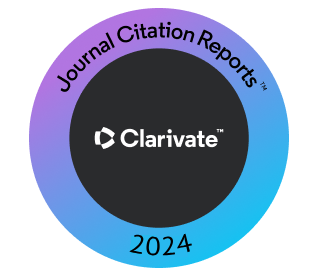Levofloxacin Determination in Pharmaceutical Tablets by Sensitive Spectrofluorometric Method with L-Tryptophan as a Fluorescent Probe
DOI:
https://doi.org/10.14500/aro.12197Keywords:
L-tryptophan, Levofloxacin, pharmaceuticals, Quenching, SpectrofluorometricAbstract
Proper dosage, therapeutic effectiveness, patient safety, and quality control throughout manufacture and storage can only be achieved by closely monitoring the concentration of pharmaceutical products. Aprecise and reliable spectrofluorometric approach for quantitative analysis and detection of levofloxacin (LEVO) in various pharmaceutical products was developed in this work using the fluorescent reagent L-tryptophan. When L-tryptophan, which has its inherent fluorescence signal quenched by LEVO, is mixed with Britton-Robinson buffer solution (pH 9.0), a stable ion-associated complex forms. The fluorescence intensity of L-tryptophan decreased at 365 nm after excitation at 281 nm. The method showed linearity for LEVO concentrations from 0.3 to 18.0 μg/mL, with a minimum detectable value of 0.10 μg/mL. An effective linear relationship (R2 = 0.9985) between the concentration and fluorescence intensity (ΔF) was obtained. This technique has been well-proven to be minimally affected by impurities commonly found in pharmaceutical formulations. The results were validated through comparative analyses with high-performance liquid chromatography. The study revealed that both equivalence levels and analytical quality (as measured by precision and accuracy) are very satisfactory. This study addresses the increasing demand for established and reliable methods in the quality control of pharmaceutical products.
Downloads
References
Abd Ali, L.I., Qader, A.F., Salih, M.I., and Aboul-Enein, H.Y., 2019. Sensitive spectrofluorometric method for the determination of ascorbic acid in pharmaceutical nutritional supplements using acriflavine as a fluorescence reagent. Luminescence, 34, pp.168-174. DOI: https://doi.org/10.1002/bio.3589
Aman, S.F., Hassan, F., Naqvi, B.S., and Hasan, S.M.F., 2010. Studies of food drug interactions. Pakistan Journal of Pharmaceutical Sciences, 23, pp.313-320.
Ashour, S., and Bayram, R., 2020. New sensitive derivatization methodology of levofloxacin antibiotic from its dosage formulations: Kinetic spectrophotometric methods for determination. Analytical Chemistry Letters, 10, pp.562-576. DOI: https://doi.org/10.1080/22297928.2020.1844594
Bano, R., Arsalan, A., Ahmad, I., and Shad, Z., 2014. Levofloxacin: A Potent Antibiotic. Baqai Medical University, Baqai Institute of Pharmaceutical Sciences, Pakistan.
Böttcher, S., Baum, H., Hoppe-Tichy, T., Benz, C., and Sonntag, H.G., 2001. An HPLC assay and a microbiological assay to determine levofloxacin in soft tissue, bone, bile and serum. Journal of Pharmaceutical and Biomedical Analysis, 25, pp.197-203. DOI: https://doi.org/10.1016/S0731-7085(00)00478-7
Chansud, N., Longnapa, N., and Bunkoed, O., 2021. A nanohybrid magnetic sensing probe for levofloxacin determination integrates porous graphene, selective polymer and graphene quantum dots. Journal of Pharmaceutical and Biomedical Analysis, 205, p.114316. DOI: https://doi.org/10.1016/j.jpba.2021.114316
Chinnaraj, S., Palani, V., Yadav, S., Arumugam, M., Sivakumar, M., Maluventhen, V., and Singh, M. 2021. Green synthesis of silver nanoparticle using goniothalamus wightii on graphene oxide nanocomposite for effective voltammetric determination of metronidazole. Sensing and Bio-Sensing Research, 32, p.100425. DOI: https://doi.org/10.1016/j.sbsr.2021.100425
Da Silva, A.P., Luna, A.S., Da Silva Costa, T., Aucelio, R.Q., Braga, J., Boqué, R., and Ferré, J., 2012. Spectrofluorimetric determination of levofloxacin in pharmaceuticals and human urine. International Journal of Life science and Pharma Research, 2, pp.147-158.
Davit, B.M., Nwakama, P.E., Buehler, G.J., Conner, D.P., Haidar, S.H., Patel, D.T., Yang, Y., Yu, L.X., and Woodcock, J., 2009. Comparing generic and innovator drugs: A review of 12 years of bioequivalence data from the United States Food and Drug Administration. Annals of Pharmacotherapy, 43, pp.1583-1597. DOI: https://doi.org/10.1345/aph.1M141
Devi, M.L., and Chandrasekhar, K., 2009. A validated stability-indicating RP-HPLC method for levofloxacin in the presence of degradation products, its process related impurities and identification of oxidative degradant. Journal of Pharmaceutical and Biomedical Analysis, 50, pp.710-717. DOI: https://doi.org/10.1016/j.jpba.2009.05.038
Duan, R., Jiang, J., Liu, S., Yang, J., Zhu, J., Qiao, M., Yan, J., and Hu, X., 2017. Spectrofluorometric determination of ascorbic acid using thiamine and potassium ferricyanide. Instrumentation Science and Technology, 45, pp.312-323. DOI: https://doi.org/10.1080/10739149.2016.1242077
Elgendy, K.H., Zaky, M., Altorky, A.E.M.M., and Fadel, S., 2024. Determination of levofloxacin, norfloxacin, and moxifloxacin in pharmaceutical dosage form or individually using derivative UV spectrophotometry. BMC Chemistry, 18, p.115. DOI: https://doi.org/10.1186/s13065-024-01193-4
El-Yazbi, A.F., Khamis, E.F., Youssef, R.M., El-Sayed, M.A., and Aboukhalil, F.M., 2020. Green analytical methods for simultaneous
determination of compounds having relatively disparate absorbance; application to antibiotic formulation of azithromycin and levofloxacin. Heliyon, 6, p.e04819. DOI: https://doi.org/10.1016/j.heliyon.2020.e04819
Gökoğlu, E., Kıpçak, F., and Seferoğlu, Z., 2014. Studies on the interactions of 3, 6-diaminoacridine derivatives with human serum albumin by fluorescence spectroscopy. Luminescence, 29, pp.872-877. DOI: https://doi.org/10.1002/bio.2635
González, J.A.O., Mochón, M.C., and De La Rosa, F.J.B., 2000. Spectrofluorimetric determination of levofloxacin in tablets, human urine and serum. Talanta, 52, pp.1149-1156. DOI: https://doi.org/10.1016/S0039-9140(00)00484-7
Hashmi, S.Z.H., Dhiman, T.K., Chaudhary, N., Singh, A.K., Kumar, R., Sharma, J.G., Kumar, A., and Solanki, P.R., 2021. Levofloxacin detection using l-cysteine capped MgS quantum dots via the photoinduced electron transfer process. Frontiers in Nanotechnology, 3, p.616186. DOI: https://doi.org/10.3389/fnano.2021.616186
Inage, F., Kato, M., Yoshida, M., Akahane, K., and Takayama, S., 1992. Lack of nephrotoxic effects of the new quinolone antibacterial agent levofloxacin in rabbits. Arzneimittel-Forschung, 43, pp.395-397.
Kaczmarek, M., Staninski, K., and Stodolny, M., 2021. New chemiluminescent method of levofloxacin and ofloxacin determination based on terbium (III)-sensitized fluoroquinolone-KBrO3 reaction. Luminescence, 36, pp.1945‑1952. DOI: https://doi.org/10.1002/bio.4128
Koeppe, M.O., Cristofoletti, R., Fernandes, E.F., Storpirtis, S., Junginger, H.E., Kopp, S., Midha, K.K., Shah, V.P., Stavchansky, S., and Dressman, J.B., 2011. Biowaiver monographs for immediate release solid oral dosage forms: Levofloxacin. Journal of Pharmaceutical Sciences, 100, pp.1628-1636. DOI: https://doi.org/10.1002/jps.22413
Lu, W., Pan, M., Ke, H., Liang, J., Liang, W., Yu, P., Zhang, P., and Wang, Q. 2022. An LC-MS/MS method for the simultaneous determination of 18 antibacterial drugs in human plasma and its application in therapeutic drug monitoring. Frontiers in Pharmacology, 13, pp.1044234. DOI: https://doi.org/10.3389/fphar.2022.1044234
Maurya, P., Kumar, A., Singh, S., Nisha, R., Pal, R.R., Chourasia, M.K., and Saraf, S.A., 2021. Bio-analytical method development for estimation of levofloxacin: Application in estimation of drug in nano-formulations and pharmacokinetic studies. Indian Journal of Pharmaceutical Education and Research, 55, pp.S814-824. DOI: https://doi.org/10.5530/ijper.55.3s.189
Mehta, J., Pancholi, Y., Patel, V., Kshatri, N., and Vyas, N., 2010. Development and validation of a sensitive stability indicating method for quantification of levofloxacin related substances and degradation products in pharmaceutical dosage form. International Journal of PharmTech Research, 2, pp.1932-1942. DOI: https://doi.org/10.1039/c0ay00405g
Meyyanathan, S., Ramasarma, G., and Suresh, B., 2003. Analysis of levofloxacin in pharmaceutical preparations by high performance thin layer chromatography. Journal of Separation Science, 26, pp.1698-1700. DOI: https://doi.org/10.1002/jssc.200301616
Nakamori, Y., Miyashita, Y., Nakatani, I., and Nakata, K., 1995. Levofloxacin: penetration into sputum and once-daily treatment of respiratory tract infections. Drugs, 49, pp.418-419. DOI: https://doi.org/10.2165/00003495-199500492-00120
Notario, D., Martono, S., Ikawati, Z., Hakim, A.R., Jannah, F., and Lukitaningsih, E., 2017. A rapid and simple high-performance liquid
chromatographic method for determination of levofloxacin in human plasma. Indonesian Journal of Chemistry, 17, pp.54-62.
Ocaña, J.A., Callejón, M., and Barragán, F.J., 2001. Determination of trovafloxacin in human serum by time resolved terbium-sensitised luminescence. European Journal of Pharmaceutical Sciences, 13, pp.297-301. DOI: https://doi.org/10.1016/S0928-0987(01)00116-6
Park, H.W., Alam, S.M., Lee, S.H., Karim, M.M., Wabaidur, S.M., Kang, M., and Choi, J.H., 2009. Optical ascorbic acid sensor based on the fluorescence quenching of silver nanoparticles. Luminescence: The Journal of Biological and Chemical Luminescence, 24, pp.367-371. DOI: https://doi.org/10.1002/bio.1119
Parys, W., Dołowy, M., and Pyka-Pająk, A., 2022. Significance of chromatographic techniques in pharmaceutical analysis. Processes, 10, p.172. DOI: https://doi.org/10.3390/pr10010172
Qader, A.F., 2024. Validated spectrofluorometric assay for folic acid determination in pure and pharmaceutical forms via basic fuchsin fluorescence quenching. Luminescence, 39, p.e70022. DOI: https://doi.org/10.1002/bio.70022
Qader, A.F., and Fakhre, N.A., 2017. Spectrofluorometric determination of furosemide in some pharmaceutical product using acriflavine as a reagent. AIP Conference Proceedings, 1888, p.020042. DOI: https://doi.org/10.1063/1.5004319
Radi, A., and El-Sherif, Z., 2002. Determination of levofloxacin in human urine by adsorptive square-wave anodic stripping voltammetry on a glassy carbon electrode. Talanta, 58, p.319-324. DOI: https://doi.org/10.1016/S0039-9140(02)00245-X
Szerkus, O., Jacyna, J., Gibas, A., Sieczkowski, M., Siluk, D., Matuszewski, M., Kaliszan, R., and Markuszewski, M., 2017. Robust HPLC-MS/MS method for levofloxacin and ciprofloxacin determination in human prostate tissue. Journal of Pharmaceutical and Biomedical Analysis, 132, pp.173-183. DOI: https://doi.org/10.1016/j.jpba.2016.10.008
Tahir, T.F., Qader, A.F., Salih, M.I., and Rashid, E.Q., 2019. L-tryptophan as fluorescent probe for determination of folic acid in some pharmaceutical products. Aro-The Scientific Journal of Koya University, 7, pp.19-26. DOI: https://doi.org/10.14500/aro.10557
Tanaka, K., Iwamoto, M., Maesaki, S., Koga, H., Kohno, S., Hara, K., Sugawara, K., Kaku, M., Kusano, S., and Sakito, O., 1992. Laboratory and clinical studies on levofloxacin. The Japanese Journal of Antibiotics, 45, pp.548-556.
Toker, S.E., Kızılçay, G.E., and Sagirli, O., 2021. Determination of levofloxacin by HPLC with fluorescence detection in human breast milk. Bioanalysis, 13, pp.1063-1070. DOI: https://doi.org/10.4155/bio-2021-0058
Üçer, A., Ertekіn, Z.C., and Dіnç, E., 2024. A comparative application of spectrophotometric and spectrofluorimetric methods to estimate levofloxacin DNA and ofloxacin-DNA interactions. Journal of Fluorescence, 35, p.123-134. DOI: https://doi.org/10.1007/s10895-024-04056-2
Une, T., Fujimoto, T., Sato, K., and Osada, Y., 1988. In vitro activity of DR3355, an optically active ofloxacin. Antimicrobial Agents and Chemotherapy, 32, pp.1336-1340. DOI: https://doi.org/10.1128/AAC.32.9.1336
Yang, H., Ran, G., Yan, J., Zhang, H., and Hu, X., 2018. A sensitive fluorescence quenching method for the detection of tartrazine with acriflavine in soft drinks. Luminescence, 33, pp.349-355. DOI: https://doi.org/10.1002/bio.3420
Zheng, X., Jongedijk, E.M., Hu, Y., Kuhlin, J., Zheng, R., Niward, K., Paues, J., Xu, B., Forsman, L.D., and Schön, T., 2020. Development and validation of a simple LC-MS/MS method for simultaneous determination of moxifloxacin, levofloxacin, prothionamide, pyrazinamide and ethambutol in human plasma. Journal of Chromatography B, 1158, p.122397 DOI: https://doi.org/10.1016/j.jchromb.2020.122397
Downloads
Published
How to Cite
Issue
Section
License
Copyright (c) 2025 Kurdo A. Abdullah, Aryan F. Qader

This work is licensed under a Creative Commons Attribution-NonCommercial-ShareAlike 4.0 International License.
Authors who choose to publish their work with Aro agree to the following terms:
-
Authors retain the copyright to their work and grant the journal the right of first publication. The work is simultaneously licensed under a Creative Commons Attribution License [CC BY-NC-SA 4.0]. This license allows others to share the work with an acknowledgement of the work's authorship and initial publication in this journal.
-
Authors have the freedom to enter into separate agreements for the non-exclusive distribution of the journal's published version of the work. This includes options such as posting it to an institutional repository or publishing it in a book, as long as proper acknowledgement is given to its initial publication in this journal.
-
Authors are encouraged to share and post their work online, including in institutional repositories or on their personal websites, both prior to and during the submission process. This practice can lead to productive exchanges and increase the visibility and citation of the published work.
By agreeing to these terms, authors acknowledge the importance of open access and the benefits it brings to the scholarly community.
Accepted 2025-06-04
Published 2025-06-24
















 ARO Journal is a scientific, peer-reviewed, periodical, and diamond OAJ that has no APC or ASC.
ARO Journal is a scientific, peer-reviewed, periodical, and diamond OAJ that has no APC or ASC.